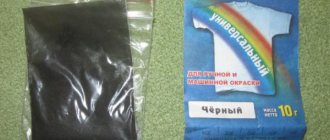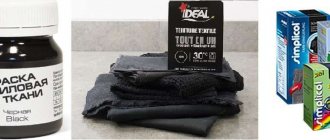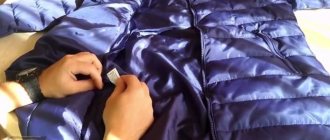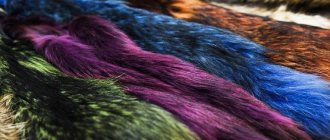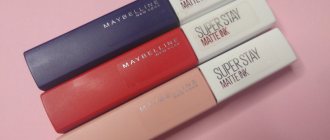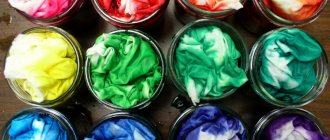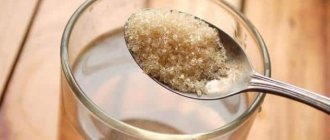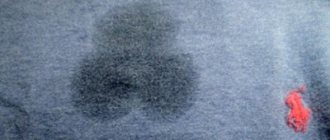Fur products of various types - fur coats, hats, vests, etc. - cost a hefty sum, and therefore are purchased for a long time. But after frequent use, the fur loses its attractiveness and needs updating. At home, you can either dye the fur a different color or refresh the natural one. It is not possible to radically repaint dark skins, but you can enhance the brightness of the original palette. You should not paint a new product; it is better to initially purchase the desired color. But an old thing can be given a new life.
So, let's figure out how to dye a fur coat or other fur product using accessible methods.
What fur can and cannot be dyed
Fur can be natural (dyed or natural) and artificial. You can paint any product, the main thing is to choose the right coloring agent.
White wool
Over time, white wool items turn yellow or dirty gray. Chlorine bleaches should not be used in such cases. You can make your wool whiter using available products. It is better to repaint things with special aniline dyes. It is recommended to bleach and dye only used clothes. It is not advisable to change the color of new things (the structure of the fibers deteriorates).
Wool bleaching products:
- 3 percent hydrogen peroxide (100 ml of peroxide per 2 liters of water);
- sodium thiosulfate (1 tablespoon of powder per 7 liters of water);
- table salt (1 tablespoon of salt per 1 liter of water);
- baking soda (2 tablespoons of soda per 4 liters of water);
- store-bought wool bleach (chlorine-free).
Arctic fox
After a few seasons, the white arctic fox turns yellow, and the color of the dyed fur becomes less intense and dull. You can restore the appearance of an arctic fox collar or fur coat by dyeing it. The main thing is to remember that you cannot paint a new product simply because you don’t like its color. It is recommended to paint only faded and yellowed Arctic foxes.
Products for dyeing fox fur:
- special aniline paint;
- acid dye;
- hair dye;
- hair lightener (chlorine-free);
- spray paint or tinting spray (Fur-Fresh).
Mink
A hat and even a mink collar can be repainted with ordinary hair dye. It is better to tint a fur coat with a tinting aerosol. You can also change the color of a fur product using aniline dye or acid dye. The easiest way is to use cream hair dye. This product can be bought at any supermarket. If the white mink has turned yellow, you can remove the yellowness using pharmaceutical hydrogen peroxide. The use of bleach with chlorine is prohibited.
Nutria
You can restore the natural color of nutria fur using alcohol or ordinary vodka. You just need to apply alcohol to a cotton swab and wipe the wool with it. After cleaning, the nutria needs to be dried, combed, and it will shine like new. It is prohibited to use bleaches containing chlorine. You can recolor your nutria using hair dye. It is better to tint with aerosol dye.
See also
How can you get white and shades of this color by mixing paints?
Beaver
Beaver fur can be dyed using hair dye. The main thing is that it is darker than beaver fur. Tinting can be done with spray paint.
Mouton
A mouton fur coat can be repainted with cream hair dye, restorative dye for nubuck and suede, tint spray or liquid hair balm or aerosol dye. Do not use chlorine bleach.
A rabbit
It is better to recolor a rabbit fur coat using hair dye. To dye rabbit fur, you can use store-bought henna, basma, and gamma. Tinting is best done using spray paint.
Sheepskin
You can dye faded sheepskin using aniline dye, hair dye or aerosol tinting paint. The white color of the product can be restored using hydrogen peroxide and ammonia.
Artificial
A huge number of paints have been developed for dyeing faux fur. The main thing is to remember that such pile should not be dyed with regular hair dye. Faux fur cannot be machine washed. It is better to remove dirt using carpet cleaning detergents.
Features of painting a mink coat
A mink coat has an excellent appearance. However, over time it also begins to fade, so painting the fur coat is inevitable. The procedure should not cause difficulties, adhere to the following scheme:
- First you need to clean the fur from dirt, then apply a rich cream to the inside.
- Moisten the villi with water by spraying them with a spray bottle.
- It is also better to apply paint using a spray bottle, after diluting it with water.
- Comb the fur with a comb and wait about half an hour.
- Remove the paint with warm water and shampoo, then rinse with conditioner and rinse the product again.
- Re-treat the inside with cream, comb the villi in the desired direction.
- Hang the fur coat to dry on a hanger.
What can you paint with?
Fur products are repainted using various dyes. In order to refresh the white color and remove yellowness, use bleaches (not chlorine).
Hair dye
The simplest, relatively cheap and accessible way to transform natural fur products is to dye them using cream hair dye for women. You can buy this product at any supermarket. When working with hair dye, the main thing is not to wet the skin (inside). It is recommended to lubricate the skins with Vaseline, baby cream or glycerin before dyeing.
Aerosol
Using aerosol paint (Salamander, Furasol) you can refresh the color of faded dyed fur. True, spray is not used to radically change the shade of a fur coat.
Expert opinion
Zakharova Irina Yurievna
Cleaning professional with 15 years of experience. Our best expert.
Ask a Question
The aerosol is used only for tinting fur products and restoring color in certain areas.
Aerosol paint is used to color long and short fur. The main thing is to choose the right color of the spray; it should match the shade of the fur product. Spray painting fur coats is very easy. You need to spray the paint over the fur at a distance of 25-40 cm and rub it into the fur with a soft brush, and then dry the product and comb it.
Peroxide and ammonia for lightening
If the pile has turned yellow, you can bleach it using 3% hydrogen peroxide and 10% ammonia solution. You can buy these whitening products at any pharmacy. In order to lighten the pile, you need to apply bleach to a cotton swab or washcloth and wipe the fur. Sometimes the clarification process needs to be repeated 2-3 times.
Potassium permangantsovka
Only natural fox fur can be dyed with a weak solution of potassium permanganate. This product is no longer suitable for any wool. But potassium permanganate returns the fox to its original color.
See also
Top 5 paints for wheels and DIY application at home
Toning with tinted shampoo
Balm, spray or shampoo for tinting women's hair can be used to dye a fur coat. Unlike paint, such products do not contain ammonia and have a more gentle effect. Light tinting is used for old fur of poor quality, which falls out and flakes off. The dye is applied to the pile for 20-40 minutes. Then wash it off with water from the shower head. The color after painting remains only on the surface of the pile, but does not penetrate inside.
Special dyes
In hardware supermarkets you can buy special paints for dyeing fur. True, some coloring products have to be ordered via the Internet. For example, acid powder dyes. These dyes are used for professional wool dyeing.
At home, faded natural fur is usually tinted with aniline dyes.
Peculiarities of working with fur of different animals (Arctic fox, mink, rabbit, etc.) and artificial
The peculiarity of natural fur is that it is more resistant to external influences. At the same time, the skins of different animals have unique characteristics:
- Arctic fox fur - it is not difficult to dye it at home, although the hairs are dense and the paint consumption will be impressive. But the result will last for a long time;
- mink coat - it is difficult to both dye and tint. The dye does not penetrate the hair well and does not last long. Fortunately, high-quality fur will not require restoration for a long time. If the time has come to dye natural mink fur, hair dye will do. In a similar way, you can refresh a mink hat and other oversized items;
- Nutria is not in many ways inferior to mink, but it is easier to dye. It will not be possible to repaint the product in a different color, but it will be possible to return the previous brightness for a while;
- beaver skin - for coloring it they use a darker palette than the native one. But you shouldn’t lighten the product, otherwise it will be difficult to get rid of the yellowness;
- silver fox – pleases with its durability, and when you need to refresh the item, only the top hairs are dyed. For a red fox, colors from a warm palette are suitable. If the fur of a silver fox requires minor correction, then things with a red tint have to be thoroughly dyed;
- Mouton - paints well, but due to the high density of the pile it is difficult to apply the paint evenly. Because of this, spots appear. It is better to dye a mouton fur coat to match the color so that the gaps are not noticeable. You can dye a mouton fur coat with either hair dye or professional fur products;
- chinchilla - easy to color, like rabbit. A white fur coat can be refreshed with hydrogen peroxide, and for colored items, use paint to match. At home, you can either dye the fur of a chinchilla or rabbit, or make the shade richer;
- sheepskin - thick cover is difficult to dye, but light-colored items can be bleached well with lemon juice, table vinegar or hydrogen peroxide.
The question remains, how and with what to dye faux fur. Aggressive products are not suitable for synthetics. But you can use all kinds of hair dyes and tints with a gentle composition. They are safe, although they do not always provide the required color fastness. Aerosols for suede and wool are also suitable, which can be used to spot-treat worn areas.
What you need for work
To dye any fur, first of all, you need to buy paint. It is advisable to completely repaint only faded products. If faded or peeling spots appear on your fur coat in some areas, it is better to touch them up with a spray. The main thing is to choose the right shade of aerosol.
Methods for dyeing fur products:
- Spread (by rubbing oxidative paint or acid dye into the fur).
- Spraying, tinting (spraying aerosol paint over the pile).
Tips that will come in handy when dyeing fur:
- the paint should be darker than the original color of the fur product;
- during the dyeing process, do not wet the skin (inner space);
- It is forbidden to repaint new things;
- It is better to tint a large fur coat with an aerosol;
- Suede paint is suitable for painting small faded areas;
- you can do highlighting (dye individual strands);
- It is better to paint with a hair coloring brush;
- You can fix the color with 9% vinegar;
- It is better to dry the product with a hairdryer (if there is a “cold air” function);
- To clean the pile, it is recommended to use a washcloth and dishwashing detergent;
- It is better to protect the skin (inner space) with glycerin.
Contacting specialists
In order to properly repaint natural fur, the product must be completely disassembled. It is recommended to dye each skin separately. It is advisable to paint using a spread method, and after dyeing, rinse the fur well in water.
Of course, with this method of coloring, the skin (inside) must be pre-treated with special means, otherwise it will harden or shrink. It is difficult to perform all these procedures at home. You need to have various chemicals on hand and know how to work with them and in what proportions to use. It is better to entrust the thing for coloring to specialists. Painting will be expensive, but the fur product will be repainted with high quality.
Source
How to prepare fur
You can repaint part of a fur product or the entire thing. The fur needs to be prepared for painting. Before dyeing, it is advisable to separate the fur collar from the main product. If you need to repaint the entire item, it is recommended to tear off the lining. Only clean things are painted. Dirty fur must be cleaned. Before cleaning the wool, it is advisable to lubricate the skin (underside) with glycerin on the reverse side.
You can place the fur coat on a wet sheet (nap side down) and use a beater to knock out dust and dirt from it.
Methods for cleaning fur products:
- a washcloth and soap solution (shampoo, washing powder, liquid soap, dishwashing detergent);
- with a damp cloth and 3% hydrogen peroxide dissolved in water;
- soft brush and solution (soda + 3% hydrogen peroxide + salt + shampoo);
- store-bought fur cleaner (Furasol cleaning spray).
When cleaning, try not to wet the skin. Only the fur is cleaned. When cleaning, it is advisable to place the fur product vertically. After cleaning with detergent, the fur should be wiped with a damp, clean washcloth and then dried with a hair dryer. After drying, clean wool should be combed with a brush.
See also
What paints need to be mixed to get yellow and its shades
Stages before painting
Any fur must be cleaned before applying paint. Otherwise, the paint will not lie evenly and will come off quickly, because dust and other dirt will not allow it to penetrate deep into the hair.
You can buy special cleaning liquids, or you can prepare them yourself:
- 1 tsp. shampoo + 5 g of ammonia + 15 g of salt + 10 g of soda;
- Vinegar + water + alcohol - proportion 1:1:1.
Mix the components and evenly distribute the resulting solution on the surface of the fur. Leave on for 3-5 minutes and then rinse off.
Try to ensure that neither the product nor the water gets on the bottom layer of fur - the inner layer. After cleaning, hang the fur coat on hangers, the collar can be pinned to the board, and the hat can be put on the jar. Leave the product to dry naturally.
IMPORTANT! You should not dry your fur with a hairdryer or near a radiator - it may shrink.
Step-by-step coloring algorithm
Before painting the main product, it is advisable to conduct a test on a small piece of fur or on a hem. Before painting, you need to put rubber or plastic gloves on your hands. It is recommended to apply the dye to the fur using a hairdressing brush for dyeing women's hair or a brush.
Painting
Stages of dyeing a fur product:
- lubricate the inside with glycerin;
- prepare a coloring agent;
- apply dye to the wool using a hair dye brush;
- dye all strands evenly;
- simultaneously with dyeing, comb hairs in the direction of natural growth;
- cover the fur with paint applied to it with plastic film;
- wait 25-45 minutes until the wool is completely dyed (the exposure time is written in the instructions for the paint);
- At the end of the exposure, wash off the paint with water using a shower head.
Lock color
After painting, it is recommended to fix the color. The new shade can be fixed using a vinegar solution (2.5 tablespoons of 9% vinegar per liter of water). You can rinse the fur with a balm dissolved in water, which is usually sold along with hair dye. After fixing the color, the fur product should be blotted with a dry terry towel.
Drying
It is advisable to dry the dyed fur in the fresh air, for example, on the balcony. You can use a household hair dryer to dry the pile. Under the influence of a stream of cool air, the wool quickly dries and becomes fluffy. The main thing is not to dry out the flesh and not to dry the fur with hot air. It is advisable to dry the pile as quickly as possible before the water saturates the skin.
Selection of shades for different fur colors
When choosing a tone for dyeing, you must keep in mind that it is not recommended to treat new mink skins in this way (they are difficult to dye).
But old ones that have been exposed to sunlight give a better effect the longer the product is worn. In addition, it has been noted that to achieve a high-quality result, it is preferable to choose colors 1-2 shades darker than the natural color.
So, to update a brown mink, you should use dark brown (Fara No. 502) or black (No. 501) paints.
Natural light colors (blue, pearl or white mink) are easier to update by choosing the same shade, for example, with Irida-M paints.
Such furs lend themselves well to darkening. It only requires greater concentration and duration of exposure (instead of 30-40 minutes - a little longer than 1 hour).
How to care for a fur product after dyeing
If the fur was dyed using a spread method (using paint), the result would be a color that is resistant to moisture and ultraviolet radiation. The shade will remain for another 2-4 seasons. The main thing in a painted product is not to get caught in the rain. The wet pile should be immediately dried with a stream of cool air and combed.
If the fur is painted by spraying, that is, using aerosol paint, the color will not last long.
After all, such a coloring agent only tints the pile. The paint will remain on your hands and objects in contact with the fur (on your bag, belt). The shade will easily come off if your fur coat is caught in heavy snow. The wet pile should be dried with a stream of cold air and combed. Faded areas can be re-touched with spray.
Other ways to dye a mink hat
You can repaint a mink hat in light colors or return yellowed fur to its original whiteness without the help of special paints.
To do this, just use:
- Potato starch. It is necessary to mix 3 tbsp until smooth. l. starch and 200 ml of ammonia. Apply the resulting mixture thoroughly to the product and rinse off after 15 minutes. This method requires long-term ventilation to eliminate the unpleasant odor, but provides a lasting effect.
Spray use
When it is necessary to eliminate partial damage to the color (most often it is the burning of the tips of the fibers in the sun), you can use suede paint, which is sold in aerosol cans.
There is no need to rinse off the composition. The method is quick and effortless.
But the result after such coloring is short-lived: the color will last no longer than one season.
The spray is convenient to use on large surfaces when you need to tint a fur coat, shawl or collar.
Caring for dyed fur
As a result of painting fur skins, individual pieces, fur caps for hats with persistent household cream hair dyes, carried out using the spread method, by rubbing the paint into the fur, we obtain a stable color.
The paint is resistant to light, water and mechanical stress when wearing fur for a long time. Such items do not require special care; the requirements are the same as for any fur product. The requirements for fur dyed by spraying are completely different. The color is not particularly durable, so it is better to protect such a product from the influence of light, water, mechanical stress and elevated temperature.
In order for the dye to stick better and the fur to shine, it can be treated with a special balm for the care of dyed hair. After this treatment, the fur becomes softer and fluffier.
Fur products require daily care, combing more often, and require thorough cleaning. Much depends on proper storage. Fur should be covered and stored in a dark place.
Source of the article: https://mehodel.ru/pokraska-mexa/pokraska-mexa-kraskoj-dlya-volos/
We dye faux fur. Preparatory stage.
- In order for the product to obtain an even color, it must be clean and dry . If it is a small item, like a bag or a hat, wash the entire item about a day before dyeing (more on this here). If washing is not possible or it is an oversized fur coat or jacket, simply dry clean it. All dirt and grease must be removed. By the time of painting, the item must be completely dry.
- Coat the wrong side of the “experimental” fabric (for hands or face) or glycerin. The fabric will become softer and more elastic, which will prevent possible tears.
- To prevent the item from shrinking, stretching and being painted evenly, it must be secured on a table, wooden cutting board or chair (depending on the size), having previously covered them with thick film. Can be purchased at gardening or construction stores. Use clothespins, stationery pins, or tacks. If you have completed the previous step with lining the inside out, there is no need to worry.
You need to prepare not only the thing, but also yourself.
- Wear clothes that you don’t mind getting dirty, tidy up your hair, wear gloves; if the smell of paint is pungent, use a respirator.
- Cover the floor with oilcloth or newspaper in those places where you might accidentally drip paint.
- Kick your pets out of the room and ask your pets not to disturb you.
- Prepare the necessary tools: flat wide synthetic brushes, a paint container (not metal!), sponges, rags, a flat comb or a clothes brush.
The process of dyeing natural fur with hair dye
Before dyeing, a fur skin or a fur cap for a hat, which you have cut out and sewn from whole skins or worn fur (an old hat or collar), must be degreased by washing, since oily and dirty hair does not dye well. Unpainted areas and stains appear.
Prepare water at room temperature in a cup, add washing powder in a small amount and wash gently. The skins should already be tested for water, as sometimes the skins swell and tear from water. To prevent the skins from tearing, wash them without sudden movements and try not to twist them when squeezing. After washing, the skin is rinsed in clean warm water, lightly wrung out and prepared for painting.
Paint preparation process
The paint is prepared according to the instructions included in the box. Squeeze the hair dye and oxidizing agent (peroxide) out of the tube into a separate bowl and mix everything well. The paint is spread onto the skin or a sewn fur cap using a sponge and rubbed into the fur. The skin is rolled up and placed in a cup. After 10 - 15 minutes they come up and rub the paint well into the fur again. They constantly watch how the skin is dyed. After half an hour, darkening of the fur appears (if the mink is dyed brown), the longer the dyeing, the darker the color. Worn fur dyes faster.
At the end of painting, the skin is rinsed in clean warm water, and then washed with powder in warm water, rinsed several times until clean water. The skin is wrapped in a towel and gently squeezed without twisting, so as not to tear. Then the skin needs to be dried.
Spray for coloring fur
Often finished fur products (hats, fur coats) look excellent when worn for a long time, but faded spots appear in some places. In this case, there is no need to paint the entire thing; it is enough to touch up the problem areas with a spray.
To dye fur, you can use aerosol paint for caring for suede. It consists of metal cans of spray paint.
Aerosol for suede care
You need to choose the right shade correctly, otherwise the dyed fur will differ sharply from the main one. The area that needs to be tinted is cleaned of dirt and can be degreased with alcohol and wiped with a swab. It is advisable to cover the fur with any material, except for tinted spots. We spray the paint at a distance of 30 -40 cm so that the fur does not stick together and a uniform color is obtained. In this way you can get an excellent result, the painted areas will not differ much from natural fur, the paint will last for several months.
And finally, one interesting question.
What if you suddenly want to bleach dark fur, that is, lighten it. Let's say there was brunette fur, and I want blond. Is it possible to use hair bleaches or is it dangerous for synthetic hair? Maybe then it’s better to try bleaches specifically for synthetics? Still, a specially designed product should not harm faux fur, because, as a rule, these are delicate bleaches.
There were two questions, yes) But the meaning is the same - how to make white out of black... or at least gray. Is it possible? Does anyone have any thoughts on this? Maybe there are lucky women who succeeded? Write in the comments, we will discuss)) I rub my hands in anticipation).
The text is completely original. Copying any elements of the article is possible only with an active link to the source!
What to do if you can't use paint?
The described technique is not suitable for artificial fur, since its structure is not as strong as that of natural fur. Also, if you are afraid of damaging or staining the product, your skin is weak, unreliable, or there are any other reasons to avoid chemical hair products, you can get by with shoe paint for suede, velor and nubuck in cans. This method will cope well with masking burnt areas. According to the instructions, you need to shake the can and apply the substance from a distance of 20 cm. To ensure that the color is evenly distributed over the entire surface, after application the paint can be “smeared” with a napkin.
If you are no longer going to wear clothes with fur and don’t know what to do with it, consider decorating your handbag, headphones and other accessories with stylish, bright and colorful fur inserts.
If you are still not sure whether to paint your product and how exactly to do it, contact a workshop and consult with specialists.
After proper dyeing in compliance with all the rules and instructions, the fur will become as soft and thick as before, and will look completely new!
It happens that with the onset of cold weather you take your favorite white down jacket out of the closet and see that it is no longer worth wearing... The down jacket itself is intact, but the white fox collar has acquired an unpleasant yellow tint
. You take off the collar with a sigh and decide that over time you will have to buy a new thing, but for now you will wear it without the excellent addition of the past - the fox trim. But don’t rush to throw the collar in the trash or cut it into fur scraps. The situation can be easily corrected.
At home, a fur collar can be dyed
using regular hair dye. And this procedure will not require much effort from you. In this article we provide step-by-step instructions for dyeing fur.
1. In order for the dye to easily penetrate into the structure of the fur, it must be degreased and cleaned of dirt
. To do this, you need to prepare a special solution. Take: - table salt - 3 teaspoons; - ammonia - 1 teaspoon; - any liquid detergent or shampoo for an animal - 1 teaspoon; — baking soda – 2 teaspoons; - water - 1 liter. We treat the fur with the solution using a brush. Then it should be thoroughly rinsed and dried.
2. It is advisable to protect the inner, lint-free side of the collar from drying out before painting. To do this, it is lubricated with glycerin or any nourishing cream. Otherwise, your collar has a high chance of tearing.
3. The best option is to dye the fur a tone darker
than he was before. But if your paint contains bleaching agents, you can achieve the original color. Since the fur of the Arctic fox is much thicker than the hair on a person’s head, we recommend stocking up on more than one tube of paint.
4. Now you can start dyeing the collar
. We use paint according to the instructions. In order for the dye to be distributed evenly, it is better to pre-moisten the fur with water. Work with gloves, apply the paint quickly, spread it over the fur with your hands - the main hair and undercoats should be thoroughly coated.
5. At the end of the dyeing time, rinse the fur generously with water. After this, rinse the collar in a vinegar solution. To rinse and add shine and volume to the fur, you can use hair conditioner instead of vinegar.
6. When our collar is rinsed, you should carefully dry it with a towel.
7. To prevent the collar from shrinking after dyeing, it must be dried on a flat surface, thoroughly straightened, stretched and pinned to the surface with needles. The collar should be dried with the fur facing up. The mesh will take the longest to dry, so before removing the fixing needles, make sure that the collar is dry on the mesh side.
How to clean silver at home
Many women prefer silver jewelry because this meta...
How to clean gold at home using improvised means
Everyone loves gold jewelry, and women are simply crazy about it. And...
How to clean suede at home
Suede is a very demanding material, so it requires specific...
How to clean a carpet at home using folk remedies
In our world of new technologies, we are already accustomed to all kinds of services...
Light in the house - creating comfort with lighting
Do we always know the reason for our bad mood or fatigue? By…
Dear Clients
Prepayment for sewing products is not less than 50% of the cost of work.
The Lynx factory also offers additional services, such as painting, cutting and hauling.
Dye
fur is produced in different colors.
We dye both individual skins and finished fur products (we do not dye sheepskin coats)
.
When painting finished fur products, be careful. Painting occurs without fabric backing
, only skins are dyed. Before painting, you are checked to see if it can be painted.
If you wish, you can check it yourself :
Take your fur item that you want to dye, lightly peel off the lining and wet the skin well.
After this, forcefully pull the soaked leather in different directions; if the leather is torn, it means that poor-quality workmanship was used in the tailoring and when painting, your product may fall apart - you CANNOT
; if the leather easily pulls to the sides, you
CAN
.
We warn you in advance, when sewing a fur product, many companies often stretch the skin to make it larger; such things can shrink up to 30% after dyeing.
.
